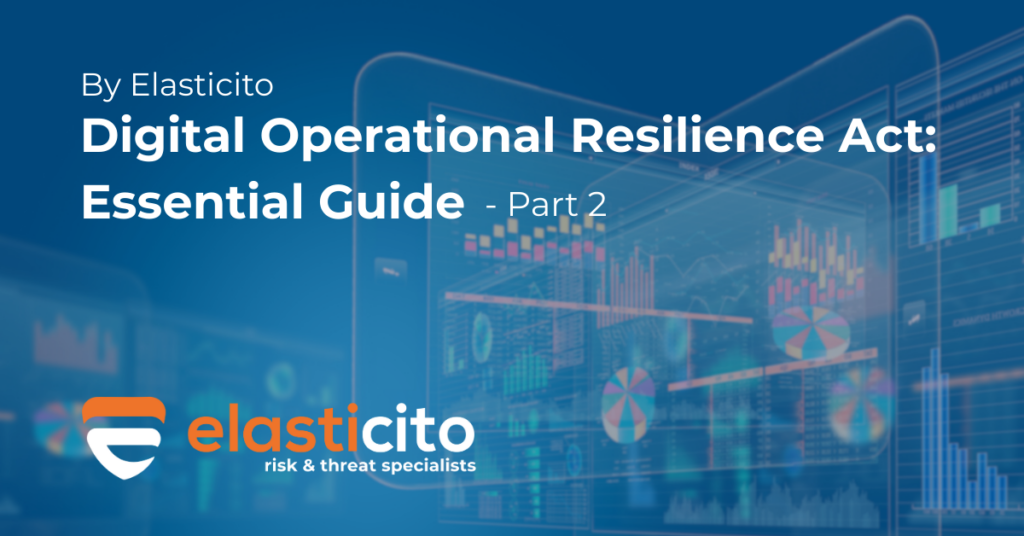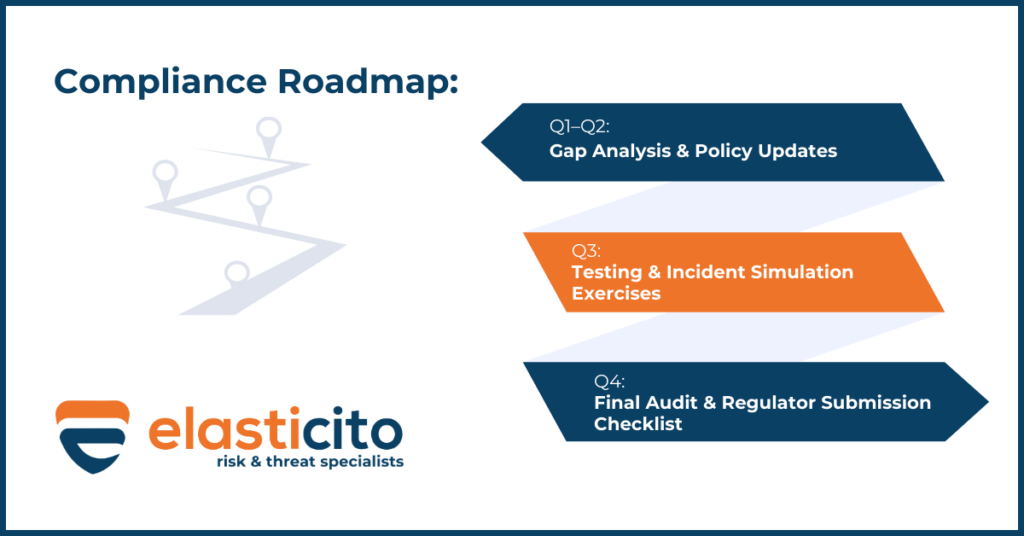The Digital Operational Resilience Act: Essential Guide – Part 2

The European financial sector faces increasing cyber threats and operational disruptions. Consequently, the sector is now subject to the Digital Operational Resilience Act (DORA). This article, the second part of our essential guide, follows our initial overview of DORA in “Digital Operational Resilience Act: Essential Guide – Part 1”. We now delve into the specific technical cybersecurity requirements and controls mandated by DORA. Our exploration will cover critical aspects including encryption, access control, network segmentation, real-time monitoring and threat detection systems. Financial entities must implement these systems to strengthen their digital defences. Furthermore, this article highlights the often-overlooked importance of contractual clauses with ICT providers. It also addresses the necessary resource allocation for testing and reporting as financial institutions actively navigate DORA compliance in 2025.
DORA Cyber Security Requirements & Technical Controls
DORA’s technical security requirements establish prescriptive standards financial entities must implement across their digital infrastructure ecosystems. These technical specifications transcend generalised guidance by mandating explicit control mechanisms across multiple ICT management domains.
Encryption, Access Control & Network Segmentation
DORA’s cyber security framework fundamentally relies upon sophisticated data protection architectures. Financial entities must deploy encryption and cryptographic controls predicated upon risk-assessment methodologies to safeguard data availability, authenticity, integrity and confidentiality. Where operational encryption of data-in-use presents technical impediments or disproportionate complexity, institutions may implement alternative ICT security measures subject to appropriate justification.
Access governance constitutes a cardinal element within DORA’s architectural requirements. Institutions must formulate explicit policies restricting physical and virtual access to ICT resources, implementing robust authentication protocols aligned with relevant technical standards. Accordingly, access privilege administration necessitates implementation through dedicated control systems incorporating appropriate protective mechanisms against unauthorised system penetration and data compromise.
Network architecture receives particular regulatory scrutiny, with DORA explicitly requiring financial entities to design network interconnection infrastructures capable of instantaneous severance when security imperatives dictate. Furthermore, network topologies must demonstrate appropriate segmentation and compartmentalisation to contain propagation risk, particularly within interconnected financial transaction environments.
Real-Time Monitoring & Threat Detection Systems
Perpetual vigilance functions as an indispensable Digital Operational Resilience Act compliance requirement. Financial entities must operationalise real-time monitoring capabilities facilitating expeditious identification and remediation of emergent threat vectors. Institutions must systematically collect, monitor and analyse telemetry from diverse sources to identify anomalous behavioural patterns, with explicit delineation of roles and responsibilities for these monitoring functions.
Automated threat detection capabilities require implementation of specific technical components, including:
- Security Information and Event Management (SIEM) architectural frameworks
- Advanced behavioural analytics incorporating machine learning algorithms
- Prioritised notification systems for incident response teams
DORA explicitly mandates that organisations maintain evidentiary documentation of ICT-related incidents facilitating subsequent forensic examination and investigative activities. Beyond detection capabilities, financial entities must establish integrated incident management workflows automating classification, handling and regulatory reporting of ICT incidents in accordance with DORA’s stringent notification chronologies.
These technical control implementations require complementary centralised management dashboards providing executive governance visibility into institutional risk posture and compliance metrics. Through this comprehensive technical security architecture, DORA establishes standardised operational resilience parameters across the EU financial services ecosystem.
Overlooking Contractual Clauses with ICT Providers
DORA’s contractual remediation obligations present exceptionally challenging obstacles for financial institutions. Notwithstanding the implementation efficiencies standardised contractual clauses would facilitate, DORA provides no such templates, thereby exponentially increasing remediation complexity. Multiple institutions continue struggling with contractual compliance parameters due to persistent ambiguity surrounding forthcoming technical standards for critical domains including subcontracting and incident reporting.
A pervasive implementation deficiency involves inadequate attention to mandatory contractual stipulations.
DORA explicitly requires financial entities to incorporate comprehensive service level agreements consolidated within a singular written document available in physical format or as downloadable, persistent digital media. Additionally, contractual instruments must incorporate:
- Unambiguous obligations compelling ICT providers to furnish incident response assistance without supplementary charges or at predetermined cost structures
- Explicit termination provisions including minimum notification periods
- Detailed provisions governing testing regimes, audit entitlements and exit strategy protocols
Financial entities frequently encounter non-negotiable template agreements presented by technical service providers on a “take-it-or-leave-it” basis. Nevertheless, regulatory accountability remains unequivocally with the financial entity, rendering effective negotiation capabilities instrumental to achieving DORA-compliant contractual arrangements.
Underestimating Resource Needs for Testing & Reporting
Financial institutions systematically underestimate resource requirements necessary for comprehensive DORA implementation. Organisations must execute thorough financial impact assessments encompassing contract review processes, personnel recruitment requirements, software acquisition costs and requisite system enhancement expenditures. Concurrently, many institutions inadequately appreciate the technical sophistication inherent in resilience testing requirements.
Testing activity implementation frequently proves exceptionally burdensome due to prescribed testing scenarios and legacy technological infrastructures potentially incompatible with DORA’s exacting ICT risk management parameters. The mandatory threat-led penetration testing (TLPT) every three years necessitates substantial technical expertise and significant financial resource allocation.
The information register requirement similarly generates substantial resource demands. Effective January 2025, all financial entities must maintain exhaustive documentation of contractual arrangements with ICT third-party service providers at entity, sub-consolidated and consolidated organisational levels. Register preparation necessitates extensive documentation protocols, sophisticated monitoring capabilities and periodic content refreshment.
Throughout DORA implementation programmes, institutions must carefully equilibrate compliance imperatives against competing operational priorities, rendering resource allocation strategies determinative factors in achieving requisite Digital Operational Resilience outcomes.
Compliance Roadmap for Financial Institutions in 2025
January 17, 2025 constitutes the definitive DORA enforcement commencement date, necessitating financial institutions’ adherence to precisely structured quarterly implementation protocols. This chronological implementation pathway delineates essential regulatory milestones requiring fulfilment throughout the compliance calendar.
Q1–Q2: Gap Analysis & Policy Updates
Early 2025 demands concentrated focus on fundamental assessment activities. Financial entities must execute comprehensive gap analysis protocols evaluating existing ICT risk management frameworks against prescribed DORA parameters. Such analytical exercises must identify compliance deficiencies across all five regulatory pillars.
Concurrently, institutional focus must shift toward preparation of Information Registers (RoI) documenting all contractual arrangements with ICT third-party service providers, requiring submission to National Competent Authorities no later than April 30, 2025. Regulatory requirements stipulate maintenance of these registers at entity, sub-consolidated and consolidated organisational echelons.
This initial semi-annual period necessarily encompasses contractual remediation activities with third-party providers, incorporating mandatory provisions addressing security requirements, data protection obligations and business continuity architectural specifications.
Q3: Testing & Incident Simulation Exercises
Quarter three necessitates prioritisation of operational resilience verification through methodical testing regimes. Regular resilience assessment protocols must employ risk-based methodologies reflecting evolving threat vectors. Emphasis requires placement on scenario-based tabletop exercises simulating significant ICT incidents.
Simultaneously, financial entities must initiate preparations for mandatory Threat Led Penetration Testing (TLPT) required triennially for critical ICT infrastructural components. Testing outcomes require comprehensive documentation, with financial institutions implementing structured remediation protocols addressing identified vulnerabilities.
Q4: Final Audit & Regulator Submission Checklist
The terminal quarter demands completion of all compliance activities preceding intensified regulatory scrutiny.
Essential tasks comprise:
- Verification that major ICT incident reporting mechanisms satisfy the 4-hour initial notification parameter
- Finalisation of automated monitoring system implementations tracking system activities and generating anomalous behaviour alerts
- Execution of internal audit procedures verifying organisational-wide DORA implementation
- Confirmation that all third-party contractual instruments incorporate requisite provisions
Throughout implementation chronologies, financial entities must recognise that supervisory investigations will concentrate on DORA compliance assessment, major ICT incident management protocols and license application procedures.

Conclusion
In conclusion, the Digital Operational Resilience Act represents a significant paradigm shift in how the European financial sector approaches and manages ICT risk. Part 2 of this guide has illuminated the specific technical security requirements, the critical need for robust contractual clauses with ICT providers, the often-underestimated resource demands for testing and reporting and the structured compliance roadmap for 2025. Successfully navigating these multifaceted requirements demands not only a thorough understanding of the regulations but also a proactive and strategic approach to implementation. As the January 17, 2025 enforcement date has now passed, financial institutions must move beyond planning and actively execute their DORA compliance strategies. The journey towards Digital Operational Resilience is ongoing, requiring continuous adaptation and vigilance in the face of an ever-evolving threat landscape.
Visit Elasticito to take the next crucial step in safeguarding your digital future.
